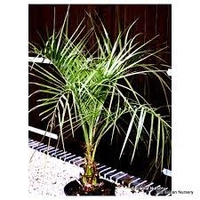Butia Palm Live Plant (Butia Capitata)
Product description
The Butia palm, also known as the Pindo palm or Jelly palm, is a popular palm tree species known for its attractive appearance and edible fruit. Here is a description of the Butia palm:
-
Appearance: The Butia palm is a medium-sized to large palm tree with a single, sturdy trunk that can reach heights of 10 to 20 feet (3 to 6 meters). The trunk is often covered in a fibrous material that gives it a rough texture. The crown of the palm features a graceful arrangement of pinnate (feather-like) fronds.
-
Leaves: The fronds of the Butia palm are arching and pinnate, with numerous long, narrow leaflets that radiate from a central stem. The leaves are typically silvery-green to bluish-green in color.
-
Fruit: One of the distinctive features of the Butia palm is its fruit, which is known as pindo or jelly palm fruit. The fruit is small, typically orange or yellow when ripe, and has a sweet, tropical flavor. It is often used to make jams, jellies, and alcoholic beverages.
-
Flowers: The Butia palm produces small, cream-colored to yellowish flowers. These flowers are often inconspicuous and grow on branched inflorescences.
-
Habitat: Butia palms are native to South America, particularly in Brazil and Uruguay. They are well-suited to subtropical and temperate climates, making them adaptable to a range of growing conditions.
-
Cultivation: Butia palms are relatively hardy and can tolerate drought conditions once established. They prefer well-draining soil and full sun but can also tolerate partial shade. These palms are often used in landscaping, both as solitary specimens and in groups.
-
Cold Tolerance: One of the remarkable characteristics of the Butia palm is its cold tolerance, especially when compared to many other palm species. Some varieties can withstand temperatures as low as 5 to 10 degrees Fahrenheit (-15 to -12 degrees Celsius) without significant damage.
-
Maintenance: These palms generally require minimal maintenance. Regular watering is essential during their establishment period, but once established, they are quite drought-tolerant. Pruning may be needed to remove dead fronds and maintain the tree's appearance.
-
Landscape Use: Butia palms are often used as ornamental trees in gardens and parks, especially in areas with a Mediterranean or subtropical climate. They provide a tropical and elegant appearance to the landscape.
Overall, the Butia palm is valued not only for its aesthetic appeal but also for its delicious fruit. It is a versatile and hardy palm species that can thrive in a variety of climates, making it a popular choice for landscaping in many regions.
✦
You might like these
✦







